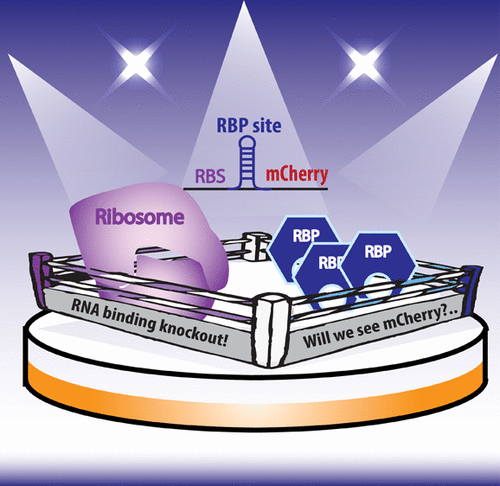当前位置:
X-MOL 学术
›
ACS Synth. Biol.
›
论文详情
Our official English website, www.x-mol.net, welcomes your feedback! (Note: you will need to create a separate account there.)
An in Vivo Binding Assay for RNA-Binding Proteins Based on Repression of a Reporter Gene
ACS Synthetic Biology ( IF 4.7 ) Pub Date : 2018-11-08 00:00:00 , DOI: 10.1021/acssynbio.8b00378 Noa Katz 1 , Roni Cohen 1 , Oz Solomon 1, 2 , Beate Kaufmann 1 , Orna Atar 1 , Zohar Yakhini 2, 3 , Sarah Goldberg 1 , Roee Amit 1, 4
ACS Synthetic Biology ( IF 4.7 ) Pub Date : 2018-11-08 00:00:00 , DOI: 10.1021/acssynbio.8b00378 Noa Katz 1 , Roni Cohen 1 , Oz Solomon 1, 2 , Beate Kaufmann 1 , Orna Atar 1 , Zohar Yakhini 2, 3 , Sarah Goldberg 1 , Roee Amit 1, 4
Affiliation

|
We study translation repression in bacteria by engineering a regulatory circuit that functions as a binding assay for RNA binding proteins (RBP) in vivo. We do so by inducing expression of a fluorescent protein–RBP chimera, together with encoding its binding site at various positions within the ribosomal initiation region (+11–13 nt from the AUG) of a reporter module. We show that when bound by their cognate RBPs, the phage coat proteins for PP7 (PCP) and Qβ (QCP), strong repression is observed for all hairpin positions within the initiation region. Yet, a sharp transition to no-effect is observed when positioned in the elongation region, at a single-nucleotide resolution. Employing in vivo Selective 2′-hydroxyl acylation analyzed by primer extension followed by sequencing (SHAPE-seq) for a representative construct, established that in the translationally active state the mRNA molecule is nonstructured, while in the repressed state a structured signature was detected. We then utilize this regulatory phenomena to quantify the binding affinity of the coat proteins of phages MS2, PP7, GA, and Qβ to 14 cognate and noncognate binding sites in vivo. Using our circuit, we demonstrate qualitative differences between in vitro to in vivo binding characteristics for various variants when comparing to past studies. Furthermore, by introducing a simple mutation to the loop region for the Qβ-wt site, MCP binding is abolished, creating the first high-affinity QCP site that is completely orthogonal to MCP. Consequently, we demonstrate that our hybrid transcriptional–post-transcriptional circuit can be utilized as a binding assay to quantify RNA–RBP interactions in vivo.
中文翻译:

一个在体内结合分析的RNA结合蛋白基于一个报告基因的镇压
我们通过设计调控电路来研究细菌中的翻译抑制,该调控电路的功能是在体内对RNA结合蛋白(RBP)进行结合测定。我们通过诱导荧光蛋白–RBP嵌合体的表达,以及在报告模块的核糖体起始区域(AUG + 11–13 nt)内的不同位置编码其结合位点来实现此目的。我们显示,当由它们的同源RBP结合时,PP7(PCP)和Qβ(QCP)的噬菌体外壳蛋白可对起始区域内的所有发夹位置观察到强烈的抑制作用。然而,当以单核苷酸分辨率定位在延伸区中时,观察到从无作用的急剧转变。用人体内通过引物延伸然后进行测序(SHAPE-seq)对代表性构建物进行分析的选择性2'-羟基酰化作用确定,在翻译活性状态下,mRNA分子是非结构化的,而在阻抑状态下,则检测到结构化的标记。然后,我们利用这一监管的现象量化噬菌体MS2,PP7,GA和Qβ至14同源和非同源结合位点的外壳蛋白的结合亲和力体内。使用我们的电路,我们证明了体外与体内之间的质量差异与过去的研究相比,各种变体的结合特性。此外,通过向Qβ-wt位点的环区引入简单突变,取消了MCP结合,从而创建了第一个与MCP完全正交的高亲和力QCP位点。因此,我们证明了我们的杂交转录-转录后电路可以用作结合试验,以定量体内RNA-RBP的相互作用。
更新日期:2018-11-08
中文翻译:

一个在体内结合分析的RNA结合蛋白基于一个报告基因的镇压
我们通过设计调控电路来研究细菌中的翻译抑制,该调控电路的功能是在体内对RNA结合蛋白(RBP)进行结合测定。我们通过诱导荧光蛋白–RBP嵌合体的表达,以及在报告模块的核糖体起始区域(AUG + 11–13 nt)内的不同位置编码其结合位点来实现此目的。我们显示,当由它们的同源RBP结合时,PP7(PCP)和Qβ(QCP)的噬菌体外壳蛋白可对起始区域内的所有发夹位置观察到强烈的抑制作用。然而,当以单核苷酸分辨率定位在延伸区中时,观察到从无作用的急剧转变。用人体内通过引物延伸然后进行测序(SHAPE-seq)对代表性构建物进行分析的选择性2'-羟基酰化作用确定,在翻译活性状态下,mRNA分子是非结构化的,而在阻抑状态下,则检测到结构化的标记。然后,我们利用这一监管的现象量化噬菌体MS2,PP7,GA和Qβ至14同源和非同源结合位点的外壳蛋白的结合亲和力体内。使用我们的电路,我们证明了体外与体内之间的质量差异与过去的研究相比,各种变体的结合特性。此外,通过向Qβ-wt位点的环区引入简单突变,取消了MCP结合,从而创建了第一个与MCP完全正交的高亲和力QCP位点。因此,我们证明了我们的杂交转录-转录后电路可以用作结合试验,以定量体内RNA-RBP的相互作用。


























 京公网安备 11010802027423号
京公网安备 11010802027423号